If you’re a pickleball enthusiast or a tennis player looking to try something new, you might be wondering if can you play pickleball on a tennis court. The answer is yes! In fact, many players enjoy playing pickleball on tennis courts. Especially when pickleball courts are not available in their area.
So, we prepared detailed step-by-step instructions for setting up pickleball on the tennis court.
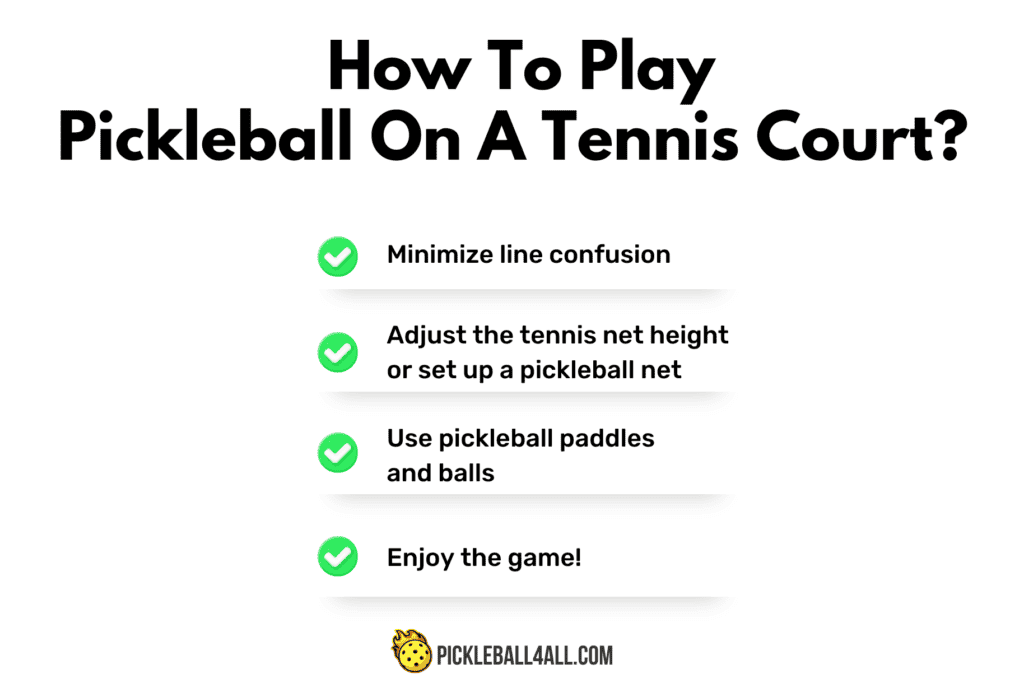
The Comparison Difference Between a Pickleball Court and a Tennis Court
While pickleball and tennis share some similarities, there are key differences. Both sports have their own set of lines on the court, with pickleball court lines being slightly different from tennis court lines. The dimensions of the court, as well as the surface, also differ. A single tennis court can accommodate one pickleball court, two or even four pickleball courts, illustrating the difference in size between the two.
Pickleball Court Dimensions vs. Tennis
Pickleball courts are smaller than tennis courts. It’s measuring 20 feet by 44 feet, while the tennis court is much larger, measuring 36 feet by 78 feet.
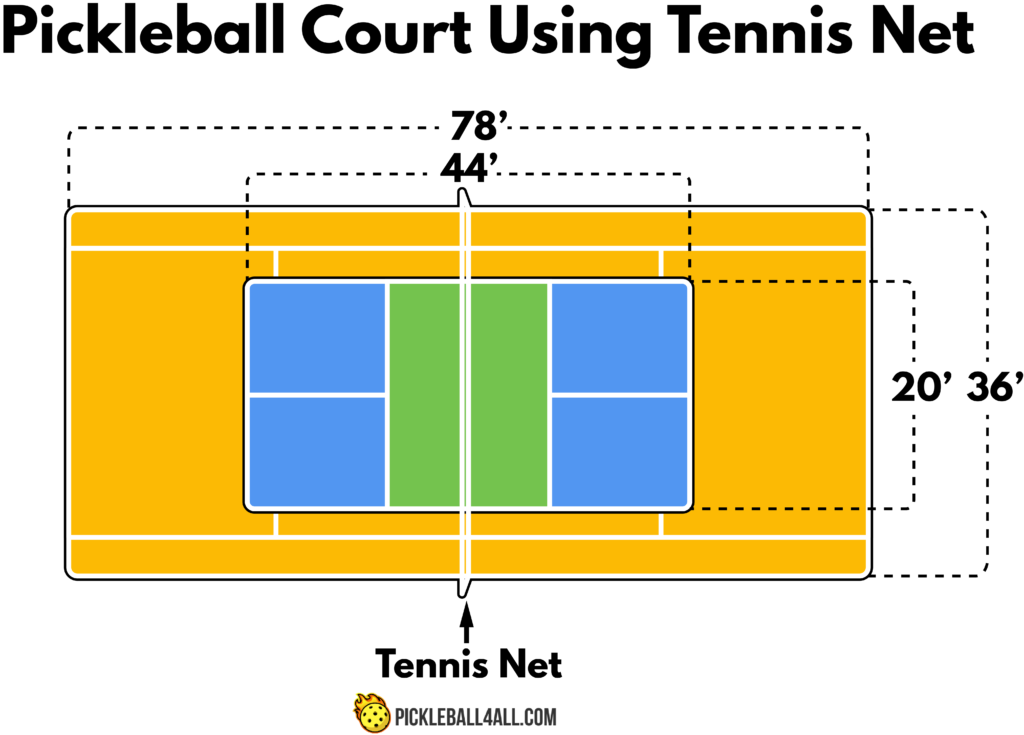
How many pickleball courts can you get on a tennis court?
It’s common practice to set up two pickleball courts on each side. So the court can accommodate up to four pickleball courts, allowing for a total of 16 players to enjoy pickleball simultaneously.
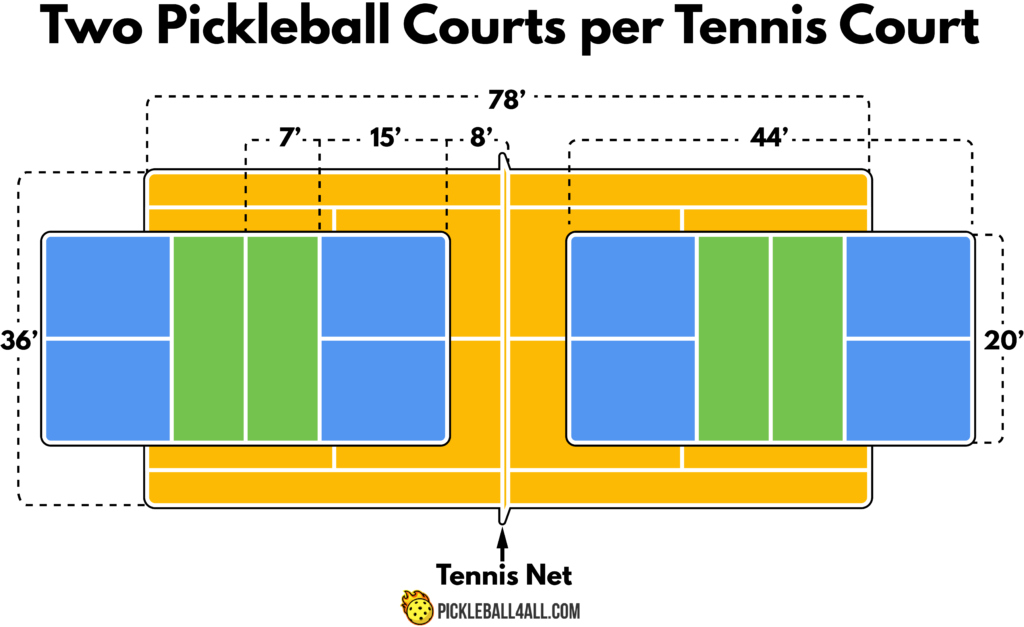
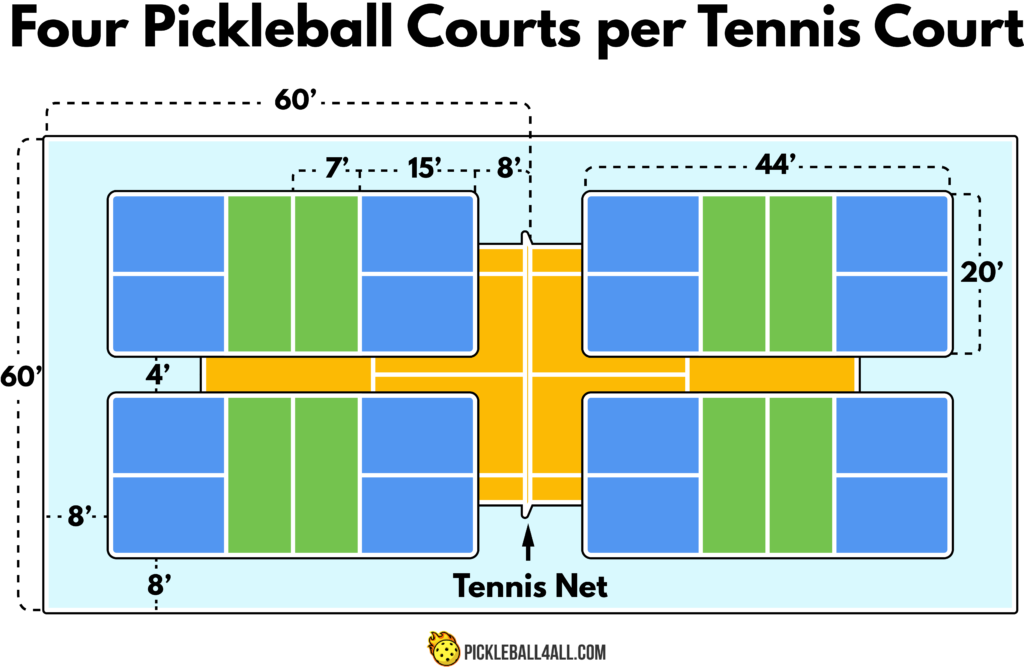
The Pickleball Lines on a Tennis Court
To avoid confusion while playing pickleball on the tennis court, it’s important to understand the differences in the lines.
In pickleball, there are additional lines called the kitchen or non-volley zone lines. They are located 7 feet from the net on both sides of the court. Tennis courts, on the other hand, do not have these additional lines. But the pickleball lines on a tennis court can be easily set up, allowing players to switch between the two sports if desired.
Pickleball court lines:
Pickleball Net Height vs Tennis
The net height is also different. Pickleball nets are 34 inches at the center, compared to tennis nets which are 36 inches at the center.
So, understanding all these differences is essential when playing pickleball on a tennis court.
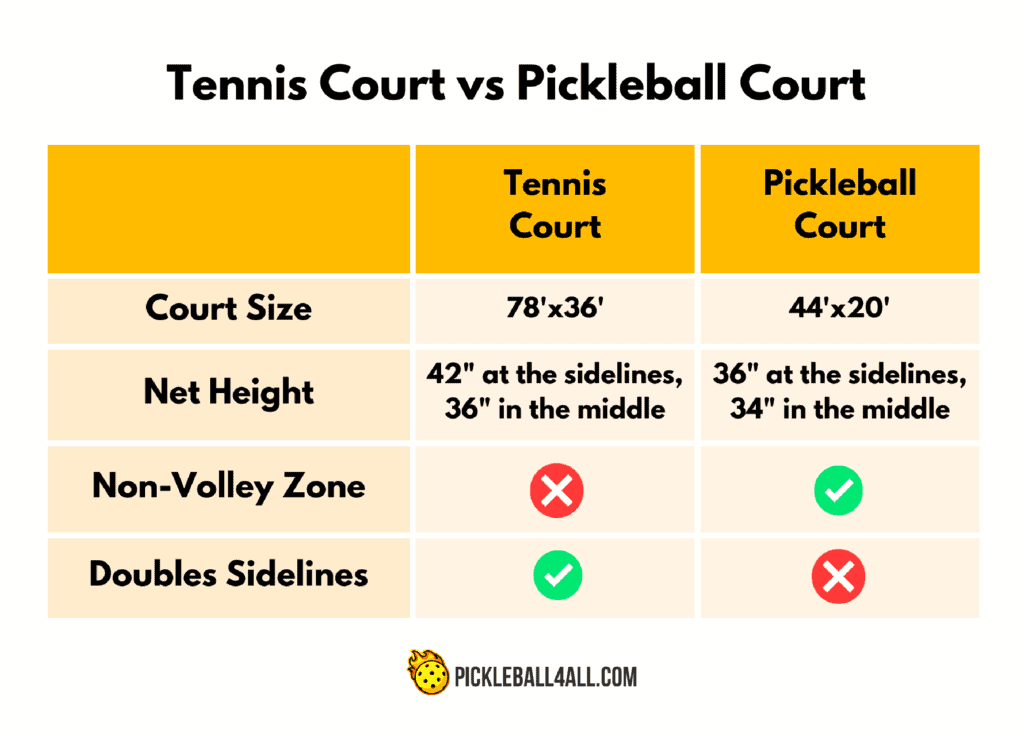
How to Play Pickleball on a Tennis Court
Let’s look at the main points of preparation – drawing pickleball lines and adjusting the tennis court net height.
Marking Pickleball Lines: Minimize Line Confusion
To minimize line confusion when playing pickleball on a tennis one, you can mark the pickleball court lines on the tennis court by yourself. You can draw pickleball lines with chalk, use temporary pickleball court tape, or paint for marking the lines.
Another option is to use pickleball court stencils. These are pre-made templates that you can place on the court, and then use spray paint or chalk to mark the lines. This can save you time and effort in drawing the lines manually and ensure accurate markings.
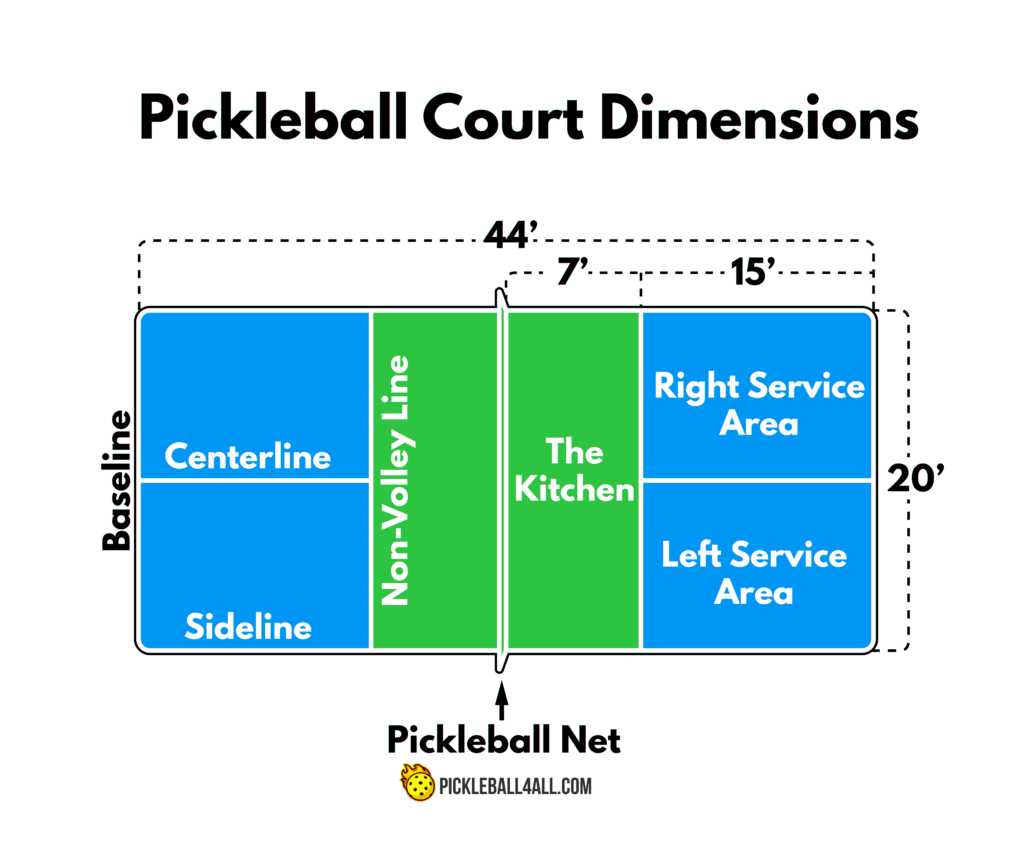
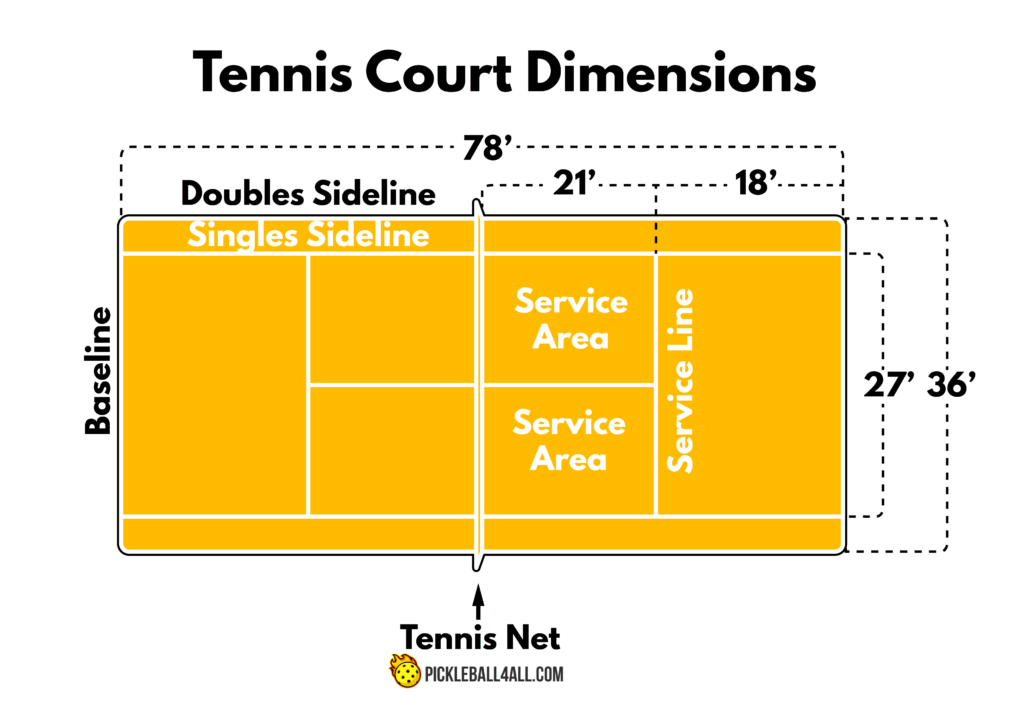
How to Draw Pickleball Lines with Chalk
Follow these steps:
Once you’ve drawn the pickleball lines on the court, make sure to use contrasting colors for better visibility. Also, be prepared to remove the markings after playing to avoid any damage to the tennis court.
How to Mark Pickleball Lines by Paint
If you prefer a more permanent solution, you can consider marking pickleball lines using paint. Be sure to use paint suitable for outdoor courts, such as acrylic or latex-based court paint, to mark the court.
Follow these steps:
It’s important to check the rules and regulations of the court facility. You should seek permission before making any permanent markings.
How to Use Pickleball Court Stencils
You’ll need to buy a pickleball court stencil kit, spray paint, a paint roller, masking tape, and measuring tape.
Follow these easy steps:
Admire Your Work!
Pro Tip: For added durability, consider applying a clear sealant over the painted lines to protect them from wear and tear.
Adjust the Tennis Net Height or Set Up a Pickleball Net
Can you play pickleball with a tennis net? Yes, you can, but the net height should be adjusted to the official pickleball height of 34 inches at the center.
You can buy a net adjuster or attach a PVC pipe to the net posts to achieve the correct height. However, many players opt for using their nets.
How to Adjust a Tennis Net to Pickleball Height
Here’s a step-by-step guide on how to adjust a tennis net to pickleball height, along with some handy tips!
- Measure the Pickleball Net Height. Grab a measuring tape or a pickleball net height gauge, and measure the net height at the center. It should be 34 inches (86.4 cm) for pickleball, which is slightly lower than the standard tennis net height.
- Lower the Tennis Net to Pickleball Height. Locate the net posts on either side of the court, and look for the mechanism to adjust the net height. It’s usually a lever or a knob on the net posts. Use it to lower the net posts until the net is at the pickleball height of 34 inches (86.4 cm) at the center.
- Secure the Tennis Net at Pickleball Height. Once you’ve lowered the net to the pickleball height, it’s crucial to secure it to prevent any accidental adjustments during play. Double-check the net height with a net height gauge, ensure the net posts are securely locked in place, and use a net strap or bungee cords to keep the net in position. Periodically check the net height during play to ensure it remains at the correct height.
How to Set Up a Pickleball Net on a Tennis Court
Some tennis courts may not have nets installed. These can be temporary or makeshift courts set up in non-traditional locations or recreational areas. For example, some community parks, schoolyards, or recreational facilities may have courts without nets. Especially in areas where tennis is not the primary sport or activity.
In some cases, tennis nets may be removed temporarily for maintenance or repair purposes, or due to weather-related issues.
To ensure a comfortable game, it’s recommended to set up your pickleball net. So you will have a proper net height for pickleball and can enjoy the game without any hindrances.
Setting up a pickleball net steps:
- Gather the Equipment. You’ll need a pickleball net, net posts, and a net height gauge.
- Position the Net Posts. Place the net posts on either side of the court, ensuring they are evenly spaced and aligned with the pickleball court lines. The net posts should be positioned so that the net height is 34 inches (86.4 cm) at the center, as per pickleball regulations.
- Attach the Net. Follow the manufacturer’s instructions to attach the net to the net posts. Typically, the net will have hooks or straps that attach to the net posts, keeping the net taut and at the correct height.
- Adjust the Net Height. Use a net height gauge to double-check that the net is at the pickleball height of 34 inches (86.4 cm) at the center. Make any necessary adjustments to ensure the net is at the correct height.
- Secure the Net. Once the net is at the correct height, use net straps or bungee cords to secure the net to the net posts, so it remains in place during play.
With these simple steps, you’ll have your pickleball net set up and ready for action on a tennis court in no time! Happy pickleballing!
How to Play Pickleball on a Tennis Court – Final Thoughts
No worries! If there’s a tennis court nearby, you can easily enjoy a game of pickleball. With proper planning and preparation, playing pickleball on a tennis court can be a fun and enjoyable experience for players of all levels. So, gather your friends, set up your pickleball lines, and get ready for an enjoyable game of pickleball on a tennis court.
FAQ
Can you play pickleball on a tennis court?
Yes, you can play pickleball on a tennis court. However, you may need to consider the court lines and markings required for pickleball to ensure proper gameplay.
How to play pickleball on a tennis court?
With these simple steps, you can easily convert an existing tennis court into a pickleball court and enjoy playing pickleball:
Step 1: Adjust the tennis net height or set up a pickleball net.
Step 2: Mark the pickleball lines on the tennis court.
How do you convert a tennis court into a pickleball court?
To convert a tennis court into a pickleball court, you need to add pickleball lines and markings. This involves painting or taping the appropriate lines on the tennis court surface to match the dimensions and layout of a pickleball court.
What is the cost of converting a tennis court into a pickleball court?
Converting a tennis court into a pickleball court can be accomplished through various methods:
1. Temporary Lines. Applying temporary lines using chalk, temporary tape, and measuring tape is a cost-effective option. All materials cost less than $25.
2. Permanent Pickleball Lines. Hiring a professional to add permanent pickleball lines to a tennis court can cost between $200 and $600. While a DIY approach using paint may seem cost-effective, it’s not recommended as mistakes can be difficult to undo. It’s important to note that adding lines to public or private courts without permission is illegal and can have consequences.
3. Complete Conversion. On average, the cost of a complete conversion from a tennis court to a pickleball one can range from $2,000 to $15,000.
4. Additional costs may be incurred if you choose to add accessories such as scoreboards or windscreens. It’s recommended to get quotes from professional court builders and compare costs to find the best option for your budget.
Can you convert any tennis court into a pickleball court?
In general, most standard tennis courts can be converted into pickleball ones. It’s important to get permission from the appropriate authorities and follow local regulations before making any modifications to a tennis court.
Do you need to make permanent markings for playing pickleball on a tennis court?
No, permanent markings are not necessary for playing pickleball on a tennis court.
Are the rules different for playing pickleball on a tennis court?
The rules for pickleball remain the same, regardless of whether you are playing on a dedicated pickleball court or a converted tennis court.
What are the benefits of converting a tennis court into a pickleball one?
Converting tennis courts into pickleball ones allows better utilization of existing court infrastructure. Additionally, it can provide an alternative option for facilities with limited space or budget for building dedicated pickleball courts.
Does pickleball damage tennis courts?
Pickleball is generally considered to be less damaging to tennis courts compared to tennis. However, pickleball can still cause some wear and tear on the tennis court surface over time, especially if played regularly.
Can you play pickleball on a paddle tennis court?
Paddle tennis courts are not the same as pickleball courts, as they have different dimensions and layouts. In some cases, pickleball can be played on a paddle tennis court with temporary lines and nets, as long as it doesn’t disrupt the original use of the paddle tennis court.
Can you play pickleball on a tennis court made of clay?
Clay tennis courts are not recommended for pickleball play. The soft and delicate nature of clay surfaces can be easily damaged by the harder pickleballs and frequent movement on the court.
Can you use a tennis net for pickleball?
Although a tennis net can be used for pickleball, it is recommended to have a pickleball net for optimal gameplay. The height of a pickleball net is slightly lower than a tennis net, which ensures the appropriate clearance and bounce during the game.
Can a pickleball net be used as a tennis net?
Yes, a pickleball net can be used as a tennis net. However, it is important to note that a pickleball net is slightly shorter in height compared to a standard tennis net.
What is a portable pickleball net?
A portable pickleball net is a lightweight and easily movable net designed specifically for pickleball. It allows you to set up a pickleball court temporarily in different locations.
How many pickleball courts can fit on a tennis court?
The number of pickleball courts that can fit on a tennis court depends on the available space and the desired layout. Typically, you can fit 4 pickleball courts on a standard tennis court by dividing it into four smaller pickleball courts.
Can I use a tennis racket to play pickleball?
Yes, you can use a tennis racket to play pickleball. However, pickleball paddles are specifically designed for the sport and provide better control and maneuverability.
Are pickleball lines on a tennis court necessary?
Yes, pickleball lines on a tennis court are necessary if you want to play pickleball on a converted tennis court. These lines indicate the specific playing areas for pickleball and help players follow the correct court dimensions.
